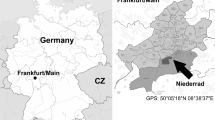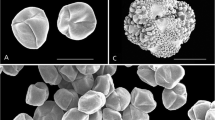Abstract
Evergreen broad-leaved plants have been cultivated in Switzerland for more than 200 years. Only in the last decades about a dozen of these species succeeded in escaping from the gardens and in spreading into the surrounding forests. Meanwhile, they have grown up to the tree layer and must be considered presently as naturalized. Former deciduous forest transformed into evergreen deciduous broad-leaved mixed forest. As temperature is the major climatic determinant for species distribution, particularly limiting the distribution of evergreen towards deciduous vegetation, the possible link between these vegetation shifts and climatic change is discussed.
Access this chapter
Tax calculation will be finalised at checkout
Purchases are for personal use only
Preview
Unable to display preview. Download preview PDF.
Similar content being viewed by others
References
Andrasko, K. 1990. Global warming and forests: an overview of current knowledge. Unasylva 163: 3–11.
Antonietti, A. 1968. Le associazioni forestall dell’orizzonte submontano del Canton Ticino su substrati pedogenetici ricchi di carbonati. Mitt. EAFV 4: 88–221.
Aschwanden, A., Beck, M., Häberli, Ch., Haller, G., Keine, M., Roesch, A., Sie, R. & Stutz, M. 1996. Klimatologie der Schweiz (Jahrgang 1996). Klimatologie 1961’1990, Heft 2, Band 1 von 4. Bereinigte Zeitreihen. Die Ergebnisse des Projektes KLIMA 90 Band 1: Auswertungen. SMA Zürich.
Becherer, A. 1960. Die Flora des Tessins und des Comerseegebietes im Lichte der neueren Erforschung. Bauhinia 1(3): 261–281.
Bettelini, A. 1904. La flora legnosa del Sottoceneri. Diss. Università Zurigo.
Box, E.O. 1994. Eastern North America: Natural Environment and Sampling Strategy. pp. 21-60. In: Miyawaki A., Iwatsuki K. & Grandtner M.M. (eds), Vegetation in eastern North America. University of Tokyo Press.
Box, E.O. 1996. Plant functional types and climate at the global scale. J. Veg. Sci. 7: 309–320.
Bright, Ch. 1997. Tracking the ecology of climate change. pp. 78-94. In: Brown L.R., Flavin C. & French H. (eds), State of the world 1997. Worldwatch, New York.
Brzeziecki, B., Kienast, F. & Wildi, O. 1995. Modelling potential impacts of climate change on the spatial distribution of zonal forest communities in Switzerland. J. Veg. Sci. 6(2): 257–268.
Carraro, G., Gianoni, G. & Gianola, G. 1987. Studio sulla presenza delle diverse specie di quercia nostrana in Ticino e della loro importanza per la selvicoltura a dipendenza della stazione e tenendo conto del fenomeno d’ibridazione. M. Sc.-Thesis, ETH Zürich: 1-198. (Polycopy.)
Carraro, G., Gianoni P., Klötzli, F., Mossi, R. & Walther, G.-R. 1999. Observed changes in vegetation in relation to climate warming. Final report NFP 31. vdf, Zürich.
Chapin, F.S. III, Bret-Harte, M.S., Hobbie, S.E. & Zhong, H. 1996. Plant functional types as predictors of transient responses of arctic vegetation to global change. J. Veg. Sci. 7: 347–358.
Christ, H. 1882. Das Pflanzenleben der Schweiz. 2nd. ed. Schulthess, Zürich.
de Groot, R.S., Ketner, P. & Ovaa, A.H. 1995. Selection and use of bio-indicators to assess the possible effects of climate change in Europe. J. Biogeograph. 22: 935–943.
Dierschke, H. 1994. Pflanzensoziologie. UTB, Ulmer, Stuttgart.
Ellenberg, H. & Rehder, H. 1962. Natürliche Waldgesellschaften der aufzuforstenden Kastanienflächen im Tessin. Schweiz. Zeitschr. Forstw. 113: 128–142.
Ellenberg, H. & Klötzli, F. 1972. Waldgesellschaften und Waldstandorte der Schweiz. Schweiz. Anst. Forst. Versuchsw. 48(4).
Fischlin, A. 1995. Assessing sensitivities of forests to climate change: experiences from modelling case studies. pp. 145-147. In: Guisan A., Holten J.I., Spichiger R. & Tessier L. (eds), Potential ecological impacts of climate change in the Alps and Fennoscandian mountains. Ed. Conserv. Jard. Bot. Genève.
Fuhrer, J. & Bader, S. 1996. Klimaänderung und Grünland. Nationales Forschungsprogramm 31. Klimaänderung und Naturkatastrophen. info 10: 11–12.
Gianoni, G., Carraro, G. & Klötzli, F. 1988. Thermophile, an laurophyllen Pflanzenarten reiche Waldgesellschaften im hyperinsubrischen Seenbereich des Tessins. Ber. Geobot. Inst. ETH, Stiftung Rübel, Zürich 54: 164–180.
Grabherr, G., Gottfried, M. & Pauli, H. 1994. Climate effects on mountain plants. Nature 369: 1–448.
Harte, J. & Shaw, R. 1995. Shifting dominance within a montane vegetation community: results of a climate-warming experiment. Science 267: 876–880.
Huntley, B. 1990. European post-glacial forests: compositional changes in response to climatic change. J. Veg. Sci. 1:507–518.
Innes, J.L. 1994. Climatic sensitivity of temperate forests. Env. Poll. 83: 237–243.
IPCC 1995. Climate change 1995. Impacts, Adaptations and Mitigation of Climatic Change: Scientific-Technical Analyses. Contribution of Working Group II to the Second Assessment Report of the Intergovernmental Panel on Climate Change.
Iversen, J. 1944. Viscum, Hedera and Ilex as climate indicators. Geologiska Foreningens i Stockholm Forhanlingar 66: 463–483.
Jäger, E. 1968. Die klimatischen Bedingungen des Areals der Dunklen Taiga und der sommergrünen Breitlaubwälder. Ber. Dtsch. Bot. Ges. 81(8): 397–408
Jäggli, M. 1924. Cenni sulla Flora Ticinese. Grassi & Co., Bellinzona.
Jahn, G. 1975. Die Vegetation als Klima-Indikator. pp. 355-362. In: Dierschke H. (ed) 1977, Vegetation und Klima. Cramer, Vaduz.
Karl, T.K., Knight, R.W. & Baker, B. 2000. The record breaking global temperatures of 1997 and 1998: Evidence for an increase in the rate of global warming? Geophysical Research Letters 27(5): 719–722.
Kienast, F., Wildi, O., Brzeziecki, B., Zimmermann, N. & Lemm, R. 1996. Klimaänderung und mögliche langfristige Auswirkungen auf die Vegetation der Schweiz. Nationales Forschungsprogramm 31. Klimaänderung und Naturkatastrophen. info 11: 11–12.
Klötzli, F. 1988. On the global position of the evergreen broad-leaved (non-ombrophilous) forest in the subtropical and temperate zones. Veröff. Geobot. Inst. ETH, Stiftung Rubel, Zürich 98: 169–196.
Klötzli, F., Walther, G.-R., Carraro, G. & Grundmann, A. 1996. Anlaufender Biomwandel in Insubrien. Verh. Ges. f. Ökol. 26: 537–550.
Klötzli, F. & Walther, G.-R. (eds) 1999a. Recent shifts in vegetation boundaries of deciduous forests, especially due to general global warming. Proceedings to the conference, Mte. Verità Schriftenreihe. Birkhäuser, Basel.
Klötzli, F. & Walther, G.-R. 1999b. Recent vegetation shifts in Switzerland. pp. 15-29. In: Klötzli F. & Walther G.-R. (eds), Recent shifts in vegetation boundaries of deciduous forests, especially due to general global warming. Proceedings to the conference, Mte. Verità Schriftenreihe. Birkhäuser, Basel.
Kny, L. 1882. Die Gärten des Lago Maggiore. Garten-Zeitung. Parey, Berlin.
Körner, Ch. 1997. Auswirkungen des erhöhten Kohlendioxidgehaltes der Atmosphäre auf die alpinen Ökosysteme. Nationales Forschungsprogramm 31. Klimaänderung und Naturkatastrophen. info 12: 6–7.
Kutner, L.S. & Morse, L.E. 1996. Reintroduction in a changing climate. pp. 23–48. In: Falk D.A., Millar C.I. & Olwell M. (eds), Restoring Diversity. Island Press, Washington D.C.
Landolt, E. 1993. Über Pflanzenarten, die sich in den letzten 150 Jahren in der Stadt Zürich stark ausgebreitet haben. Phytocoenologia 23: 651–663.
Larcher, W. 1964. Winterfrostschäden in den Parks und Gärten von Arco und Riva am Gardasee. Veröff. Museum Ferdinandeum Innsbruck 43: 153–199.
Leibundgut, H. 1962. Waldbauprobleme in der Kastanienstufe Insubriens. Schweiz. Zeitschr. Forstw. 113: 164–188.
Lescop-Sinclair, K. & Payette, S. 1995. Recent advance of the arctic treeline along the eastern coast of Hudson Bay. J. Ecol. 83: 929–936.
Mai, D.H. 1995. Tertiäre Vegetationsgeschichte Europas. Fischer, Stuttgart.
Oberdorfer, E. 1964. Der insubrische Vegetationskomplex, seine Struktur und Abgrenzung gegen die submediterrane Vegetation in Oberitalien und in der Südschweiz. Beitr. naturk. Forsch. SW-Deutschl. 23(2): 41–187.
Parco botanico del cantone Ticino. undated. Isole di Brissago. Guida ufficale.
Pfister, M. 1977. Sonnenstube Tessin. Ringier, Zürich.
Rickli, M. 1907. Zur Kenntnis der Pflanzenwelt des Kts. Tessin. Ber. Schweiz. Bot. Ges. 17: 27–63.
Sakai, A. & Larcher, W. 1987. Frost survival of plants. Ecol. Stud. 62. Springer, Berlin, Heidelberg.
Scherzinger, W. 1996. Naturschutz im Wald. Qualitätsziele einer dynamischen Waldentwicklung. Ulmer, Stuttgart.
Schröter, C. 1926. Exkursion der Volkshochschule ins Tessin. 1-9. (Polycopy).
Schröter, C. 1936. Flora des Südens. Rascher, Zürich.
Schmid, E. 1956. Flora des Südens. 2nd. ed. Rascher, Zürich.
Song, Y. 1983. Die räumliche Ordnung der Vegetation Chinas. Tuexenia 3: 131–157.
Song, Y. 1999. The historical shift of the evergreen broad-leaved forest in East-China. pp. 253-272. In: Klötzli F. & Walther G.-R. (eds), Recent shifts in vegetation boundaries of deciduous forests, especially due to general global warming. Proceedings to the conference, Mte. Verità Schriftenreihe. Birkhäuser, Basel.
Voigt, A. 1920. Beiträge zur Floristik des Tessins. Mitt. bot. Mus. Univ. Zürich 85: 332–357.
Walder, M. 1985. Die Auswirkungen des Kälteeinbruchs im Januar 1985 auf wärmeliebende Pflanzen in einem Tessiner Garten. Schweiz. Beitr. zur Dendrologie 35: 189–199.
Walter, H. & Breckle, S.-W. 1983–91. Ökologie der Erde. Band 1-4. Fischer, Stuttgart.
Walter, H. & Lieth, H. 1960–67. Klimadiagramm-Weltatlas. Fischer, Jena.
Walther, G.-R. 1995. Ausbreitung und Grenzen laurophyller Arten im Südtessin. M. Sc.-Thesis, ETH Zürich: 1-37 + Annex (Polycopy).
WMO 1994. Climate variability, agriculture and forestry. Report of the CAgM-IX Working Group on the study of climate effects on agriculture including forests, and of the effects of agriculture and forests on climate. Technical note No. 196, WMO-No. 802. Secretariat of the World Meteorological Organization, Geneva.
Woodward, F.I. 1987. Climate and plant distribution. Cambridge University Press, London.
Woodward, F.I. & Williams, B.G. 1987. Climate and plant distribution at global and local scales. Vegetatio 69: 189–197.
Zazanashvili, N. 1999. On the Colkhic vegetation. pp. 181-197. In: Klötzli F. & Walther G.-R. (eds), Recent shifts in vegetation boundaries of deciduous forests, especially due to general global warming. Proceedings to the conference, Mte. Verità Schriftenreihe. Birkhäuser, Basel.
Zuber, R.K. 1979. Untersuchungen über die Vegetation und die Wiederbewaldung einer Brandfläche bei Locarno (Kanton Tessin). Beiheft zu Zeitschr. Schweiz. Forstverein 65.
Author information
Authors and Affiliations
Editor information
Editors and Affiliations
Rights and permissions
Copyright information
© 2001 Springer Science+Business Media New York
About this chapter
Cite this chapter
Walther, GR. (2001). Laurophyllisation — A Sign of a Changing Climate?. In: Burga, C.A., Kratochwil, A. (eds) Biomonitoring: General and Applied Aspects on Regional and Global Scales. Tasks for vegetation science, vol 35. Springer, Dordrecht. https://doi.org/10.1007/978-94-015-9686-2_13
Download citation
DOI: https://doi.org/10.1007/978-94-015-9686-2_13
Publisher Name: Springer, Dordrecht
Print ISBN: 978-90-481-5621-4
Online ISBN: 978-94-015-9686-2
eBook Packages: Springer Book Archive




